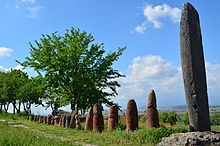Mezamor (historical site)
Mezamor is a historic site in the northwestern Armenian province of Armavir . The desert was inhabited from the Bronze Age to the 17th century AD. The most important finds from Mezamor include a copper hut from the 4th millennium BC, an agate frog owned by the Babylonian ruler Ulam Vurarish (late 16th century BC) and a carnelian seal on which Egyptian hieroglyphs can be seen are.
location
The historical Mezamor is located about 35 km southwest of Yerevan, in the area of the village of Taronik, on the bank of the Mezamor River near the modern city of Mezamor . The city was built on a volcanic hill at the crossroads of trade routes that crossed the Araratic Plain and connected Central Asia with the Northern Caucasus. A fertile plain with large water resources stretches around the city.
history
As a result of the excavations started in 1965, Mezamor was a flourishing commercial culture and center of power in the region from the fourth to the second millennium BC in the Bronze Age. At that time the city covered an area of around 10.5 hectares, was surrounded by a Cyclops wall and had a ziggurat . At the latest from the eleventh to the ninth century BC (the early Iron Age ), Mezamor was a city that comprised a fortress, an observatory, several residences and the dwellings of the simple residents (round houses with adjoining outbuildings) and spread over an area of almost 100 hectares extended. Mezamor was also one of the most important administrative, political and cultural centers of the Araratic Plain during this period. Palace buildings, a temple complex with seven sanctuaries and production rooms were discovered in the castle district within the Cyclops wall. Hellenistic artifacts found within the fortress walls are unusual . The remains of a copper smelter from the fourth millennium BC, which are evidence of the metalworking in Mezamor, are considered to be an important find. The entire complex of the smelter with the furnace and boilers built into the rock is well preserved.
500 meters northeast of the historic city area was the almost 100 hectare cemetery, where important finds were also unearthed. Some of the graves there are bordered with colored tuff bands and provided with dolmens . Members of the local upper class were buried in them and with them horses, large and small horned cattle, dogs, pigs, but also servants and slaves were carried to their graves in side burials . Since the corresponding persons who were buried at the secondary burials were still alive at the time of the death of the main person, they were either killed before the burial or, depending on the grave site, also buried alive . Some people also speak of human sacrifice . Other grave goods included enamelled ceramic pots, wooden caskets decorated with traditional mythological scenes, and jewelry made of gold, silver and semi-precious stones. Vessels for pears and wine prove the importance of these foods for the residents of that time.
In the eighth century BC, the city became part of the Urartian Empire . Traces of wars, devastation and fires date back to this time. A short gap in the settlement follows. Shortly after the destruction, the city was evidently repopulated on behalf of the new rulers, who built a new Cyclops wall. Mezamor remained an important trading settlement at the intersection of several trade routes during the Middle Ages and was inhabited until the 17th century.
museum
The Mezamor historical-archaeological museum opened in 1968. It is operated by the Service for the protection of Historical environment and cultural Museum-Reservations , a non-commercial state organization. It shows more than 27,000 finds from mezamor on three floors. On the first floor, the museum presents finds from the castle district and from the burial ground. On the second floor, handicrafts and culture are themed in the historical mezamor. Finds from the period of the Urartian Empire and jewelry can be seen on the ground floor. The most extraordinary finds presented there include an agate frog owned by the Babylonian ruler Ulam Vurarish (late 16th century BC) and a carnelian seal on which Egyptian hieroglyphs can be seen. It probably came from the possession of the Babylonian ruler Kuri-galzu I (14th century BC).
Web links
Individual evidence
- ↑ a b c d e f g “METSAMOR” HISTORICAL-ARCHEOLOGICAL MUSEUM-RESERVE . In: Service for the Protection of Historical Environment and Cultural Museum-Reservations . ( hushardzan.am [accessed November 30, 2017]). “METSAMOR” HISTORICAL-ARCHEOLOGICAL MUSEUM-RESERVE ( Memento of the original dated February 8, 2018 in the Internet Archive ) Info: The archive link was inserted automatically and has not yet been checked. Please check the original and archive link according to the instructions and then remove this notice.
- ↑ Metsamor Fortress. Retrieved November 30, 2017 .
- ↑ Metsamor Fortress. Retrieved November 30, 2017 .
Coordinates: 40 ° 7 ′ 34.6 ″ N , 44 ° 11 ′ 12.5 ″ E



